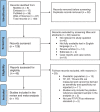The diagnostic performance of lung ultrasound for detecting COVID-19 in emergency departments: A systematic review and meta-analysis
- PMID: 35261033
- PMCID: PMC9088324
- DOI: 10.1002/jcu.23184
The diagnostic performance of lung ultrasound for detecting COVID-19 in emergency departments: A systematic review and meta-analysis
Abstract
Purpose: To perform a systematic review and meta-analysis of published literature investigating the use of lung ultrasound (LUS) on COVID-19 patients, in emergency point of care settings, and to determine its diagnostic value compared with lung computed tomography (LCT) diagnostic performance. Whilst using the real-time polymerase chain reaction test as the 'gold standard'.
Methods: Literature searches were performed on MEDLINE, Embase, Web of Science, and PubMed databases for eligible studies. The LUS and LCT pooled diagnostic performance were measured using DerSimonian-Laird random effect method.
Result: Out of a total of 158 studies, 16 met the eligibility criteria and were included in this review. The pooled sensitivity, specificity, positive and negative likelihood ratios were 86.9%, 62.4%, 2.4 and 0.19, respectively for LUS and 93.5%, 72.6%, 3.3 and 0.05, respectively for LCT.
Conclusion: The lung ultrasound (LUS) demonstrated acceptable sensitivity but poor specificity when used independently to diagnose COVID-19 pneumonia patients in emergency departments, while the lung computed tomography showed higher performance. Thus, LUS can be used to supplement existing diagnostic tools and possibly for the triage of patients.
Keywords: COVID-19; lung computed tomography; lung ultrasound; meta-analysis; systematic review.
© 2022 Wiley Periodicals LLC.
Figures




References
Publication types
MeSH terms
Grants and funding
LinkOut - more resources
Full Text Sources
Medical
Miscellaneous

